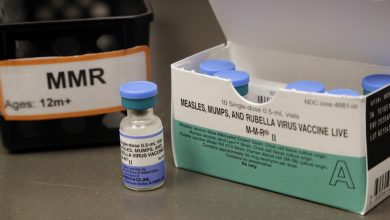Scientists develop blood test that can detect Alzheimer’s
علماء يطورون اختبارا للدم قادر على تشخيص الزهايمر
DailyMail
Washington: Scientists have devised a way to detect signs of Alzheimer’s disease through a simple, inexpensive, blood test.
The new blood-based test developed by a cadre of scientists from the UK, the US, Sweden, and Italy paves the way for cheap and easy diagnostics that could help millions of Americans begin treatment for the disease in very early stages.
To diagnose Alzheimer’s, scientists look for three distinct markers of the disease: an abnormal buildup of plaques in the brain as well as neurodegeneration, the gradual process in which nerve cells lose function and die.
The researchers set out to make a blood test capable of detecting nerve cell damage specific to the brain to measure neurodegeneration, a reliable marker of disease. While early results were promising, researchers did not disclose when patients could expect to have access to the new test.
Early detection of signs of disease is key to slowing cognitive erosion and the scientific community is racing to develop more diagnostic tools SIMPLIFY THIS, such as a highly accurate blood test called soluble oligomer binding assay (SOBA) which detects toxic clumps of amyloid beta that build up in the brain.
Dr Thomas Karikari, senior author and psychiatry professor at the University of Pittsburgh said: ‘At present, diagnosing Alzheimer’s disease requires neuroimaging.
‘Those tests are expensive and take a long time to schedule, and a lot of patients, even in the U.S., don’t have access to MRI and PET scanners. Accessibility is a major issue.’
Alzheimer’s is typically diagnosed via neuroimaging and analysis of cerebrospinal fluid collected in a lumbar puncture, also called a spinal tap.
But brain scans are expensive and can take a long time to schedule, while a spinal tap is invasive and sometimes painful.
Generally, the best indicator that nerve cells are dying that scientists can glean from blood plasma is by measuring the amount of protein called neurofilament light chain, or NfL,
But NfL is not the most ideal measuring stick. NfL ‘is unable to differentiate between Alzheimer’s disease and other dementias due to its increases in a wide range of neurodegenerative disorders,’ according to the researchers.
‘Consequently, the dementia research field currently lacks a blood biomarker that is specifically altered as a result of Alzheimer-type neurodegenerative changes.’
The newly developed blood test targets a protein called ‘brain-derived tau’ (BD-tau), which is not only detectable in blood tests but strongly correlates with Alzehiemer’s-related neurodegeneration in cerebrospinal fluid.
BD-tau levels in the blood of Alzheimer’s patients matched those in the cerebrospinal fluid sample and could reliably distinguish Alzheimer’s from other neurodegenerative diseases such as Parkinson’s and other dementias.
‘The most important utility of blood biomarkers is to make people’s lives better and to improve clinical confidence and risk prediction in Alzheimer’s disease diagnosis,’ Dr Karikari said.
The elevated levels of BD-tau in the blood also corresponded with the severity of amyloid plaques and tau tangles in the brain, proving that the proteins can be a reliable gauge for neurological illness.
Dr Karikari added: ‘A blood test is cheaper, safer and easier to administer, and it can improve clinical confidence in diagnosing Alzheimer’s and selecting participants for clinical trial and disease monitoring.’
Alzheimer’s, a chronic neurodegenerative disease that affects more than six million Americans, is characterized by a loss of communication among neurons in the brain, resulting in loss of function and cell death.
In a brain afflicted with Alzheimer’s, abnormal levels of certain naturally occurring proteins clump together to form plaques that collect between neurons and disrupt cell function.
قنا
واشنطن: استطاع علماء الأحياء الجزيئية في جامعة /بيتسبرغ / الأمريكية تطوير أول اختبار دم بقدرة عالية جدا تتجاوز 85 بالمئة، للكشف عن علامات مرض الزهايمر، دون استخدام التشخيص الوظيفي وأخذ عينات من السائل الدماغي النخاعي.
وأشارت الجامعة إلى أن هذا الاكتشاف سيبسط ويقلل تكلفة تشخيص مرض الزهايمر.
ووفقا لتوماس كاريكاري الأستاذ المساعد: “يتطلب تشخيص مرض الزهايمر حاليا استخدام أنظمة التصوير بالرنين المغناطيسي وأشكال أخرى من التشخيص الوظيفي.. كل هذه الأمور باهظة الثمن، وتستغرق وقتا طويلا، مما يجعل هذه التقنيات غير متاحة للعديد من المرضى، لقد ابتكرنا بديلا رخيصا وبأسعار معقولة”.
وطور كاريكاري وزملاؤه، نهجا جديدا لتحديد المرض، مع احتمال كبير جدا لوجود جزيئات بروتين “تاو” بشكل غير منتظم في عينات الدم، إنه أحد أهم جزيئين سامين يعتقد أنهما يساهمان بشكل كبير في تطور الخرف ومظاهر أخرى للزهايمر.
ولطالما اعتقد العلماء، أن بروتين “تاو” التالف يتراكم تدريجيا في الخلايا العصبية لحاملي المرض، وبالكاد يتركهم قبل أن تبدأ هذه الخلايا في الموت بشكل جماعي، ولهذا السبب، لم يعتبره علماء الأحياء والأطباء في السابق علامة بيولوجية محتملة لاكتشاف الخرف في المراحل المبكرة من تطوره.
ولهذا فقد طور العلماء تقنية جديدة تميز جزيئات بروتين “تاو” عن الأشكال الأخرى من المادة التي قد تكون موجودة في مجرى الدم لأسباب لا علاقة لها بمرض الزهايمر، وأدى هذا إلى زيادة القيمة التشخيصية لهذا المؤشر الحيوي بشكل كبير، مما دفع العلماء إلى الاعتقاد بأنه يمكن استخدامه للكشف عن الخرف في جميع مراحل تطوره.
ووفقا للتقديرات الحالية لمنظمة الصحة العالمية، فإن مرض الزهايمر وأشكالا أخرى من خرف الشيخوخة، تؤثر على ما يقرب من 50 مليون شخص في جميع أنحاء العالم اليوم، وبحلول عام 2030، قد يرتفع عددهم إلى 75 مليونا، إلى جانب النوبات القلبية والسكتات الدماغية، ولطالما كانت هذه المشاكل أحد الأسباب الرئيسية للوفاة في دول العالم الأول.




